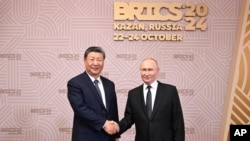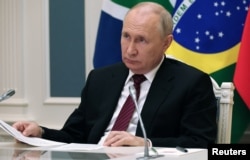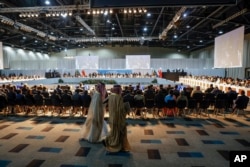
Welcome back to the China In Eurasia briefing, an RFE/RL newsletter tracking China's resurgent influence from Eastern Europe to Central Asia. This is a special edition focused on the BRICS summit in Kazan, Russia and where the organization is headed.
I'm RFE/RL correspondent Reid Standish and here's what I'm following right now.
The Bricks Within BRICS
As Russian President Vladimir Putin hosts leaders for the 16th annual BRICS summit, he's determined to show the West that he still has important allies by his side after nearly three years of attempts to isolate Russia for its full-scale invasion of Ukraine.
But while Putin is getting the optics he wants, what kind of an organization is BRICS actually growing into?
Finding Perspective: The summit in Kazan, which began on October 22 and will run until October 24, is the first meeting for the group since Egypt, Ethiopia, Iran, and the United Arab Emirates joined past members Brazil, Russia, India, China, and South Africa.
Putin is looking to use BRICS, or BRICS+ as the expanded format is sometimes termed, to signal that Russia has plenty of influential friends, despite its pariah status in the West.
The summit is intended to showcase the group's collective economic might and also entice new countries into a coalition that Moscow and Beijing hope will help form a new world order not dominated by the West.
In Kazan, Putin is expected to push negotiations to build an alternative platform for international payments that would be immune to Western sanctions.
Russia, the world's top wheat exporter, will also propose the creation of a BRICS grain-trading exchange as an alternative to Western markets where international prices for agricultural commodities are set.
But not all BRICS members completely align with the anti-Western stance coming from Beijing and Moscow and this divide could come out in Kazan.
The Balancing Act: While all BRICS members may be united in the "belief that the current structures that govern the international order and the global economy are unfairly weighted toward the Western world," Stewart Patrick, a senior fellow at the Carnegie Endowment for International Peace, told me, there is a division between China, Iran, and Russia, which want to unseat the current order, and others who want to reform it.
Many BRICS members, like Brazil and India, still work closely with the United States and other countries in the West, even as they seek to gain more global leverage.
For many of the new members, with the exception of Iran -- and also for many that have applied to join recently -- BRICS holds mostly economic appeal.
Members and would-be members alike are also looking for alternative sources of financing than available from the World Bank and International Monetary Fund (IMF), and are looking to gain better access to burgeoning markets that could better define the global economy in the coming decades.
Why It Matters: Beyond the financial appeal of the bloc, many countries also view BRICS as a form of geopolitical insurance.
And that hedge is even more relevant given added unpredictability brought to the United States in recent years.
Still, the divisions within BRICS -- and the bloc's so far thin track record in delivering on its initiatives -- could continue to hold it back.
China, Iran, and Russia represent a group within BRICS that are grappling to varying degrees with U.S. sanctions and fighting different types of proxy battles with the United States around the world.
Others, like Egypt, are leading recipients of U.S. military aid or like the United Arab Emirates, host U.S. military bases.
Adding to those difficulties in articulating what a shared vision for the BRICS would look like, China and India have difficult relations, while there is little warmth to be found between Arab states and Iran.
Three More Stories From BRICS
1. Punching Back In Kazan
Beijing and Moscow are keen to see BRICS expand further, and the Kremlin invited representatives from another 20 countries who have expressed interest in membership to participate in this year's summit.
Here's what has happened so far.
The Details: China, which has championed expansion within the bloc, is seen as the unofficial powerhouse of BRICS.
This year's summit could also set the stage for further expansion, with a growing lineup of countries applying to join, including Azerbaijan, Belarus, Turkey, Mongolia, and Sri Lanka.
Putin will also host bilateral summits with the leaders in attendance (his press service said that he will hold 17 in total), including one already with Chinese leader Xi Jinping, which marked the fourth face-to-face meeting between the two leaders since Russia's invasion of Ukraine in early 2022.
"At present, the world is going through changes unseen in a hundred years, the international situation is intertwined with chaos," Xi told Putin in Kazan.
Moscow has grown increasingly reliant on Beijing to sustain its war effort, and despite Western pressure, both China and Russia have deepened their relationship.
Russia's expanded trade links with China and India have helped it weather the bite of Western sanctions and Putin will be looking to create more pathways around the Western financial system during the summit.
"BRICS has been and can be an even bigger lifesaver for the Russian economy as it's looking for new markets," Carlos Solar, a senior fellow at the Royal United Services Institute, told me.
2. De-Dollarization
The main unifying message of the BRICS has been that a counterweight to the West in global politics and trade is needed, and reducing global reliance on the U.S. dollar has been a growing target.
What It Means: For over a decade, such ambitions have been a focus of BRICS policymakers and reducing the dollar's dominance could give members insulation from Western sanctions, both now and in the future.
And during the August 2023 summit, there was discussion of creating a BRICS currency, which did not materialize.
Yet, today, the vast majority of cross-border transactions involving BRICS members and other emerging markets continue to be invoiced in dollars.
Despite a rise in the use of Chinese renminbi, there is no clear agreement as to what could replace the dollar and many are also skeptical that any new BRICS currency would be stable enough to be trusted for cross-border transactions.
Despite the obstacles ahead, proposals are still on the table. The summit in Kazan will discuss the idea of a BRICS payment system, known as BRICS Bridge, as a type of alternative to the SWIFT payment system.
If it were to take off, this could help Russia -- or any other country under sanctions -- overcome issues sending and receiving money in global commerce.
3. Kazakhstan Hits Pause
While BRICS eyes more expansion, Kazakhstan caught observers off-guard when it said that it will "most likely" refrain from joining the group of countries.
What You Need To Know: Kazakh presidential press secretary Berik Uali told Kazakh media on October 16 that Kazakhstan had received a proposal to become a BRICS member, but that the Central Asian country didn't plan to join and would prioritize its relations through the United Nations.
Some analysts have said that Kazakhstan joining BRICS could strain its relationships with the West, which could affect investments and economic partnerships, and throw its foreign policy off-balance.
Others have also noted that the announcement ahead of the summit may have rubbed Russia the wrong way. The day after the comments, Russia banned fruit and lentil exports from Kazakhstan.
Other countries have also approached BRICS membership with caution. Saudi Arabia was formally invited to join the group, but has not yet officially accepted and Crown Prince Muhammad bin Salman will not be in Kazan.
Argentina was also invited to join, but President Javier Milei pulled out in December 2023 shortly after taking office.
Across The Supercontinent
New Sanctions Expected: The United States is set to announce new sanctions as early as next week aimed at curbing Russia's Ukraine war efforts, U.S. Treasury Secretary Janet Yellen said on October 22.
Chinese firms, which have sustained Russia, are likely to be targeted. On October 17, Washington imposed sanctions on two Chinese companies and an affiliated Russian company involved in making and shipping drones that Russia has used in Ukraine.
Guterres In Town: Putin will meet with UN Secretary-General Antonio Guterres in Kazan on October 24, the last day of the BRICS summit.
Locked On Taiwan: China held a live-firing exercise from its territory closest to Taiwan one week after it launched a large-scale drill encircling the island.
Fanning The Flames: U.S. intelligence officials warned on October 22 that "foreign actors" from Russia, China, and Iran were intent on fanning narratives to divide Americans ahead of the November 5 U.S. presidential election and beyond.
One Thing To Watch
Xi and Indian Prime Minister Narendra Modi are both attending the BRICS summit in Russia as they inch toward a reassessment period. Both countries see each other as potential future adversaries and have grappled with tensions recently, including after many Indian and Chinese soldiers died in border disputes.
But they are now reportedly working toward a truce and observers will be watching how Xi and Modi interact in Kazan.
That's all from me for now. Don't forget to send me any questions, comments, or tips that you might have.
Until next time,
Reid Standish
If you enjoyed this briefing and don't want to miss the next edition, subscribe here. It will be sent to your inbox every Wednesday.









